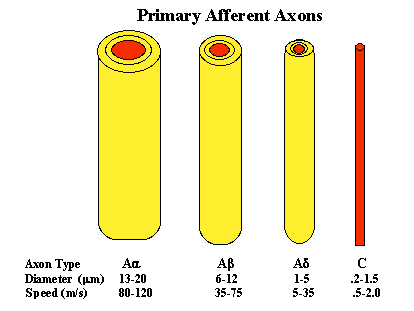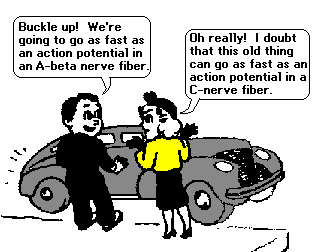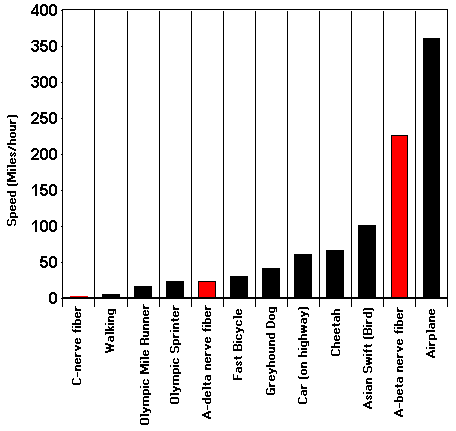Neuroscience For Kids
Conduction Velocity

The information about touch and pain is transmitted to the spinal cord and brain by primary afferent axons - these are the nerve fibers connected to the different types of receptors in the skin, muscle and internal organs. These primary afferent axons come in different diameters and can be divided into different groups based on their size. Here, in order of decreasing size, are the different nerve fiber groups: A-alpha, A-beta, A-delta and C-nerve fibers. A-alpha, A-beta and A-delta nerve fibers are insulated with myelin. C-nerve fibers are unmyelinated. The thickness of the nerve fiber is correlated to the speed with which information travels in it - the thicker the nerve fiber, the faster information travels in it.

 |
More information about the different primary afferent axons:
|
 To understand how these different types of nerve fibers work, think
about this the next time you stub you toe. First you will feel the touch
sensation of your toe hitting the ground. This is because the information
related to your toe touching the ground is carried by the large, fast
conducting A-beta nerve fibers...this reaches your brain first. A little
bit later you will feel the pain because the information related to tissue
damage (to your toe) is carried by slower conducting A-delta and C-nerve
fibers. OUCH! Here's more
information about pain.
To understand how these different types of nerve fibers work, think
about this the next time you stub you toe. First you will feel the touch
sensation of your toe hitting the ground. This is because the information
related to your toe touching the ground is carried by the large, fast
conducting A-beta nerve fibers...this reaches your brain first. A little
bit later you will feel the pain because the information related to tissue
damage (to your toe) is carried by slower conducting A-delta and C-nerve
fibers. OUCH! Here's more
information about pain.
Use the graph below to study how the speed of action potentials travel in different types of primary afferent nerve fibers. Action potentials in C-nerve fibers travel only about 2.2 mph - slower than you can walk. A-delta nerve fibers can conduct action potentials as fast as a sprinter in the Olympics. The large A-beta nerve fibers, which transmit information related to touch, can have action potentials traveling near the speeds of airplanes. Perhaps you can add to this graph - how fast can you run? how fast does a turtle walk?

Copyright © 1996-2019, Eric H. Chudler All Rights Reserved.
